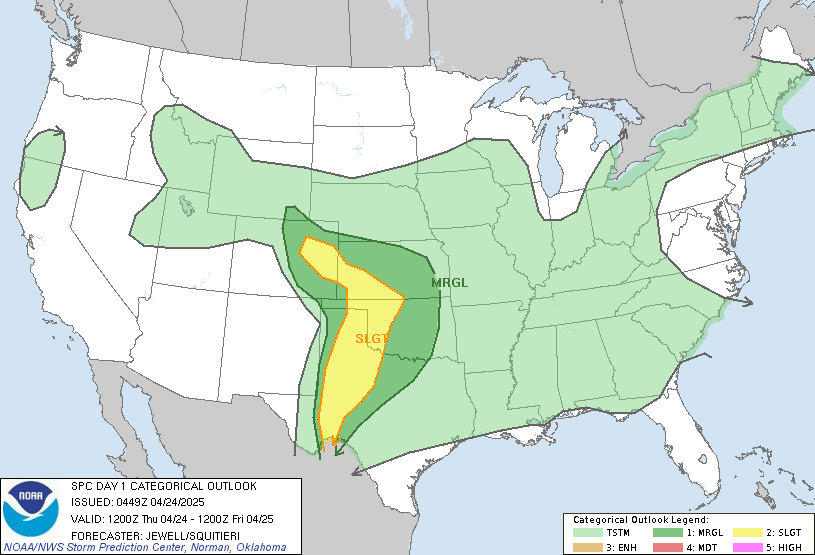LIVE MAP (ABOVE) ... SPC 1300Z Day 1 Outlook
Day 1 Convective Outlook
NWS Storm Prediction Center Norman OK
0732 AM CDT Tue Jul 22 2025
Valid 221300Z - 231200Z
...THERE IS A SLIGHT RISK OF SEVERE THUNDERSTORMS ACROSS PARTS OF
THE NORTHERN PLAINS INTO THE UPPER MISSISSIPPI VALLEY...
...SUMMARY...
Scattered severe thunderstorms will be possible over parts of the
northern Plains into the upper Mississippi Valley later today into
tonight.
...Synopsis...
Large-scale upper ridging will remain anchored over the MS Valley
and Southeast today. A positively tilted upper trough will persist
over the Northwest and northern Rockies, with enhanced southwesterly
mid-level flow continuing though the period over the northern
Plains. At the surface, a weak low is forecast to gradually develop
eastward across western/central SD by this evening, with a lee
trough extending southward from this low across the central High
Plains. A convectively reinforced boundary extending northeastward
from the surface low into northern MN may act as a focus for robust
thunderstorm development later today.
...Northern Plains into the Upper Mississippi Valley...
Extensive convective overturning has occurred overnight across the
northern Plains into parts of MN, with scattered to numerous
thunderstorms generally remaining sub-severe while tracking
east-northeastward along/north of the surface front. This activity
has been aided by a southerly low-level jet across the Plains, which
is forecast to gradually weaken though midday. While isolated hail
or strong to severe gusts may occur with ongoing thunderstorms, the
net effect of this convection may be to displace the surface
boundary farther south than most guidance indicates. In the wake of
this early day convection and associated weak mid-level shortwave
trough, heights are forecast to remain neutral or even rise slightly
through the day across much of ND/SD into MN. This weak/nebulous
large-scale forcing casts considerable uncertainty regarding
convective development with eastward extent across the Dakotas into
MN this afternoon and evening.
Even so, it does appear probable that thunderstorms will once again
form along/near the Bighorns in northern WY/southern MT, as a weak
embedded mid-level perturbation and related jet overspread the
northern High Plains. This region will generally be post-frontal,
but steep mid-level lapse rates combined with diurnal heating of the
modestly moist low-level airmass should still aid in the development
of at least weak instability by the time convection initiates this
afternoon. Strong deep-layer shear should support supercells
initially, with associated threat for large to perhaps isolated very
large hail. Some potential should exist for this convection to grow
upscale this evening across parts of the Dakotas and pose a greater
threat for severe/damaging winds overnight. But, uncertainty remains
high regarding the placement of this possible cluster, and whether
it will remain surface-based or elevated.
Farther east into the upper MS Valley, it appears less likely that
robust convection will develop before this evening due to the
stabilizing influence of the ongoing morning activity. If
thunderstorms can develop later, most short-term guidance continues
to suggest that sufficient airmass recovery will occur to support
severe convection with mainly a hail/wind threat. Sufficient
low-level shear should also be present near the front to support
some risk for a tornado. This activity would probably remain tied
close the surface boundary, with less potential for a
forward-propagating MCS into central/southern MN. Accordingly, have
trimmed the southern extent of the Slight Risk in MN. Finally, a MCV
related to extensive convection in KS yesterday is forecast to
develop northeastward across IA this afternoon/evening. Sufficient
instability and shear should be present with this feature to support
an isolated threat for severe thunderstorms, assuming convection can
develop and persist.
...Central High Plains...
Scattered to numerous high-based thunderstorms should develop this
afternoon along/near the surface lee trough extending southward
across the central High Plains. While low/mid-level flow and
deep-layer shear are all expected to remain weak today across this
region due to closer proximity to the upper ridge, low-level lapse
rates should become steepened through the afternoon and early
evening with ample daytime heating. Given the deeply mixed boundary
layer forecast, any of this high-based convection could produce
occasional strong to severe wind gusts. Have therefore expanded the
Marginal Risk southward a bit into eastern CO and western KS to
account for this potential.
...Southeast...
A weak cold front will shift southward today across parts of GA/SC.
A rather moist low-level airmass will be in place ahead of the
front, with daytime heating encouraging the development of moderate
to locally strong instability through the afternoon. Scattered
thunderstorms that develop along/ahead of the front, and along
various sea breeze circulations, may be capable of producing
occasional damaging winds, even though shear will remain weak.
..Gleason/Grams.. 07/22/2025
Read more CHECK UPDATE ZOOM GRAPHIC
http://dlvr.it/TM3BnP
Windy.com Temps | Gusts | WU KORD KPWK |
CLICK for this month's BIG night sky ... | RADAR FULL MAP SCREEN |
|---|
MOBILE DEVICE? Turn sideways. Weather conditions directly above are near Lakefront. Top tabs refer to O'Hare (official).
Archives for the SPC Convective Outlook are updated daily (approximately) with a live map at the beginning of each article. Follow the link at the end of the article to check for current updates on the NOAA/NWS Storm Prediction Center website. Also, see Archives for Chicago's hourly weather data on CARDINAL NEWS Magazine.
CONVECTIVE | TORNADO | WIND | HAIL
O'Hare International Airport KORD
(Arlington Heights South)
Chicago Executive Airport KPWK
(Arlington Heights North)
Tuesday, July 22, 2025
SPC Jul 22, 2025 1300 UTC Day 1 Convective Outlook
SUNRISE AND SUNSET TIMES IN UTC (if you're not logged in to Google)
CHICAGO UTC-6 during CST (Central Standard Time, e.g., winter)
CHICAGO UTC-5 during CDT (Daylight Savings Time, e.g., summer)
CHICAGO UTC-6 during CST (Central Standard Time, e.g., winter)
CHICAGO UTC-5 during CDT (Daylight Savings Time, e.g., summer)





















